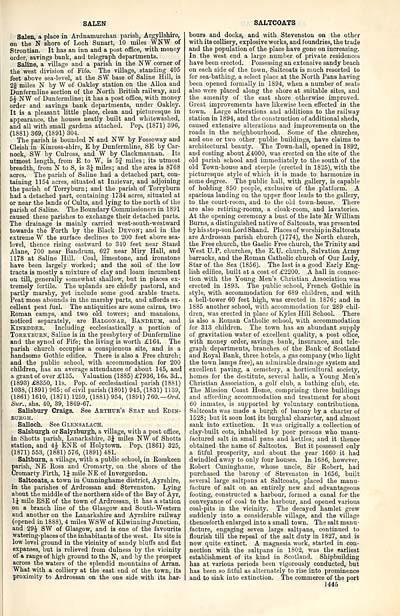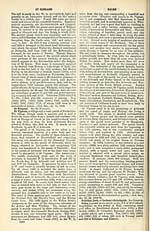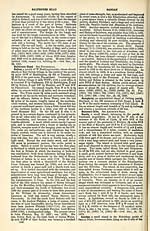Ordnance gazetteer of Scotland
(1453) Page 1445
Download files
Complete book:
Individual page:
Thumbnail gallery: Grid view | List view

SALEN
Salen, a place in Ardnamurchan parish, Argyllshire,
on the N shore of Loch Sunart, 10 miles WNW of
Strontian. It has an inn and a post office, with money
order, savings bank, and telegraph departments.
Saline, a village and a parish in the NW corner of
the west division of Fife. The village, standing 405
feet above sea-level, at the SW base of Saline Hill, is
2g miles N by W of Oakley station on the Alloa and
Dunfermline section of the North British railway, and
5£ NW of Dunfermline; it has a post office, with money
order and savings bank departments, under Oakley.
It is a pleasant little place, clean and picturesque in
appearance, the houses neatly built and whitewashed,
and all with small gardens attached. Pop. (1871) 396,
(1881) 369, (1891) 304.
The parish is bounded N and NW by Fossoway and
Cleish in Kinross-shire, E by Dunfermline, SE by Car-
nock, SW by Culross, and W by Clackmannan. Its
utmost length, from E to W, is 5| miles; its utmost
breadth, from N to S, is 3£ miles; and the area is 8768
acres. The parish of Saline had a detached part, con-
taining 1154 acres, situated at Inzievar, and adjoining
the parish of Torryburn; and the parish of Torryburn
had a detached part, containing 1734 acres, situated at
or near the lands of Cults, and lying to the north of the
parish of Saline. The Boundary Commissioners in 1891
caused these parishes to exchange their detached parts.
The drainage is mainly carried west-south-westward
towards the Forth by the Black Devon; and in the
extreme W the surface declines to 200 feet above sea-
level, thence rising eastward to 340 feet near Stand
Alane, 700 near Bandrum, 627 near Miry Hall, and
1178 at Saline Hill. Coal, limestone, and ironstone
have been largely worked; and the soil of the low
tracts is mostly a mixture of clay and loam incumbent
on till, generally somewhat shallow, but in places ex-
tremely fertile. The uplands are chiefly pastoral, and
partly marshy, yet include some good arable tracts.
Peat moss abounds in the marshy parts, and affords ex-
cellent peat fuel. The antiquities are some cairns, two
Roman camps, and two old towers; and mansions,
noticed separately, are Balgonar, Bandrum, and
KlNEDDER. Including ecclesiastically a portion of
Torryburn, Saline is in the presbytery of Dunfermline
and the synod of Fife; the living is worth £164. The
parish church occupies a conspicuous site, and is a
handsome Gothic edifice. There is also a Free church;
and the public school, with accommodation for 200
children, has an average attendance of about 145, and
a grant of over £135. Valuation (1885) £7936, 16s. 3d. ,
(1893) £8350, lis. Pop. of ecclesiastical parish (1881)
1038, (1891) 965; of civil parish (1801) 945, (1831) 1139,
(1861) 1610, (1871) 1259, (1881) 954, (1891) 760.— Ord.
Sur., shs. 40, 39, 1869-67.
Salisbury Craigs. See Arthur's Seat and Edin-
burgh.
Salloch. See Glensalach.
Salsburgh or Salysburgh, a village, with a post office,
in Shotts parish, Lanarkshire, 3 \ miles NW of Shotts
station, and 4| ENE of Holytown. Pop. (1861) 325,
(1871) 553, (1881) 576, (1891) 481.
Saltburn, a village, with a public school, in Rosskeen
parish, NE Ross and Cromarty, on the shore of the
Cromarty Firth, 1J mile NE of Invergordon.
Saltcoats, a town in Cunninghame district, Ayrshire,
in the parishes of Ardrossan and Stevenston. Lying
about the middle of the northern side of the Bay of Ayr,
1 \ mile ESE of the town of Ardrossan, it has a station
on a branch line of the Glasgow and South- Western
and another on the Lanarkshire and Ayrshire railway
(opened in 1888), 4 miles WSW of Kilwinning Junction,
and 29£ SW of Glasgow, and is one of the favourite
watering-places of the inhabitants of the west. Its site is
low level ground in the vicinity of sandy bluffs and flat
expanses, but is relieved from dulness by the vicinity
of a range of high ground to the N, and by the prospect
across the waters of the splendid mountains of Arran.
What with a colliery at the east end of the town, its
proximity to Ardrossan on the one side with its har-
SALTCOATS
bours and docks, and with Stevenston on the other
with its colliery, explosive works, and foundries, the trade
and the population of the place have gone on increasing.
In the west end a large number of private residences
have been erected. Possessing an extensive sandy beach
on each side of the town,. Saltcoats is much resorted to
for sea-bathing, a select place at the North Pans haviDg
been opened formally in 1894, when a number of seats
also were placed along the shore at suitable sites, and
the amenity of the east shore otherwise improved.
Great improvements have likewise been effected in the
town. Large alterations and additions to the railway
station in 1894, and the construction of additional sheds,
caused extensive alterations and improvements on the
roads in the neighbourhood. Some of the churches,
and one or two other public buildings, have claims to
architectural beauty. The Town-hall, opened in 1892,
and costing about £4000, was erected on the site of the
old parish school and immediately to the south of the
old Town-house and steeple (erected in 1825), with the
picturesque style of which it is made to harmonize in
some degree. The public hall, with gallery, is capable
of holding 850 people, exclusive of the platform. A
spacious landing on the upper floor leads to the gallery,
to the court-room, and to the old town-house. There
are also retiring-rooms, a cloak-room, and lavatories.
At the opening ceremony a bust of the late Mr William
Burns, a distinguished native of Saltcoats, was presented
by his step-son Lord Shand. Places of worship in Saltcoats
are Ardrossan parish church (1774), the North church,
the Free church, the Gaelic Free church, the Trinity and
West U. P. churches, the E. U. church, Salvation Army
barracks, and the Roman Catholic church of Our Lady,
Star of the Sea (1856). The last is a good Early Eng-
lish edifice, built at a cost of £2200. A hall in connec-
tion with the Young Men's Christian Association was
erected in 1893. The public school, French Gothic in
style, with accommodation for 689 children, and with
a bell-tower 60 feet high, was erected in 1876; and in
1885 another school, with accommodation for 289 chil-
dren, was erected in place of Kyles Hill School. There
is also a Roman Catholic school, with accommodation
for 313 children. The town has an abundant supply
of gravitation water of excellent quality, a post office,
with money order, savings bank, insurance, and tele-
graph departments, branches of the Bank of Scotland
and Royal Bank, three hotels, a gas company (who light
the town lamps free), an admirable drainage system and
excellent paving, a cemetery, a horticultural society,
homes for the destitute, several halls, a Young Men's
Christian Association, a golf club, a bathing club, etc.
The Mission Coast Home, comprising three buildings
and affording accommodation and treatment for about
60 inmates, is supported by voluntary contributions.
Saltcoats was made a burgh of barony by a charter of
1528; but it soon lost its burghal character, and almost
sank into extinction. It was originally a collection of
clay-built cots, inhabited by poor persons who manu-
factured salt in small pans and kettles; and it thence
obtained the name of Saltcotes. But it possessed only
a fitful prosperity, and about the year 1660 it had
dwindled away to only four houses. In 1686, however,
Robert Cuninghame, whose uncle, Sir Robert, had
purchased the barony of Stevenston in 1656, built
several large saltpans at Saltcoats, placed the manu-
facture of salt on an entirely new and advantageous
footing, constructed a harbour, formed a canal for the
conveyance of coal to the harbour, and opened various
coal-pits in the vicinity. The decayed hamlet grew
suddenly into a considerable village, and the village
thenceforth enlarged into a small town. The salt manu-
facture, engaging seven large saltpans, continued to
flourish till the repeal of the salt duty in 1827, and is
now quite extinct. A magnesia work, started in con-
nection with the saltpans in 1802, was the earliest
establishment of its kind in Scotland. Shipbuilding
has at various periods been vigorously conducted, but
has been so fitful as alternately to rise into prominence
and to sink into extinction. The commerce of the port
1445
Salen, a place in Ardnamurchan parish, Argyllshire,
on the N shore of Loch Sunart, 10 miles WNW of
Strontian. It has an inn and a post office, with money
order, savings bank, and telegraph departments.
Saline, a village and a parish in the NW corner of
the west division of Fife. The village, standing 405
feet above sea-level, at the SW base of Saline Hill, is
2g miles N by W of Oakley station on the Alloa and
Dunfermline section of the North British railway, and
5£ NW of Dunfermline; it has a post office, with money
order and savings bank departments, under Oakley.
It is a pleasant little place, clean and picturesque in
appearance, the houses neatly built and whitewashed,
and all with small gardens attached. Pop. (1871) 396,
(1881) 369, (1891) 304.
The parish is bounded N and NW by Fossoway and
Cleish in Kinross-shire, E by Dunfermline, SE by Car-
nock, SW by Culross, and W by Clackmannan. Its
utmost length, from E to W, is 5| miles; its utmost
breadth, from N to S, is 3£ miles; and the area is 8768
acres. The parish of Saline had a detached part, con-
taining 1154 acres, situated at Inzievar, and adjoining
the parish of Torryburn; and the parish of Torryburn
had a detached part, containing 1734 acres, situated at
or near the lands of Cults, and lying to the north of the
parish of Saline. The Boundary Commissioners in 1891
caused these parishes to exchange their detached parts.
The drainage is mainly carried west-south-westward
towards the Forth by the Black Devon; and in the
extreme W the surface declines to 200 feet above sea-
level, thence rising eastward to 340 feet near Stand
Alane, 700 near Bandrum, 627 near Miry Hall, and
1178 at Saline Hill. Coal, limestone, and ironstone
have been largely worked; and the soil of the low
tracts is mostly a mixture of clay and loam incumbent
on till, generally somewhat shallow, but in places ex-
tremely fertile. The uplands are chiefly pastoral, and
partly marshy, yet include some good arable tracts.
Peat moss abounds in the marshy parts, and affords ex-
cellent peat fuel. The antiquities are some cairns, two
Roman camps, and two old towers; and mansions,
noticed separately, are Balgonar, Bandrum, and
KlNEDDER. Including ecclesiastically a portion of
Torryburn, Saline is in the presbytery of Dunfermline
and the synod of Fife; the living is worth £164. The
parish church occupies a conspicuous site, and is a
handsome Gothic edifice. There is also a Free church;
and the public school, with accommodation for 200
children, has an average attendance of about 145, and
a grant of over £135. Valuation (1885) £7936, 16s. 3d. ,
(1893) £8350, lis. Pop. of ecclesiastical parish (1881)
1038, (1891) 965; of civil parish (1801) 945, (1831) 1139,
(1861) 1610, (1871) 1259, (1881) 954, (1891) 760.— Ord.
Sur., shs. 40, 39, 1869-67.
Salisbury Craigs. See Arthur's Seat and Edin-
burgh.
Salloch. See Glensalach.
Salsburgh or Salysburgh, a village, with a post office,
in Shotts parish, Lanarkshire, 3 \ miles NW of Shotts
station, and 4| ENE of Holytown. Pop. (1861) 325,
(1871) 553, (1881) 576, (1891) 481.
Saltburn, a village, with a public school, in Rosskeen
parish, NE Ross and Cromarty, on the shore of the
Cromarty Firth, 1J mile NE of Invergordon.
Saltcoats, a town in Cunninghame district, Ayrshire,
in the parishes of Ardrossan and Stevenston. Lying
about the middle of the northern side of the Bay of Ayr,
1 \ mile ESE of the town of Ardrossan, it has a station
on a branch line of the Glasgow and South- Western
and another on the Lanarkshire and Ayrshire railway
(opened in 1888), 4 miles WSW of Kilwinning Junction,
and 29£ SW of Glasgow, and is one of the favourite
watering-places of the inhabitants of the west. Its site is
low level ground in the vicinity of sandy bluffs and flat
expanses, but is relieved from dulness by the vicinity
of a range of high ground to the N, and by the prospect
across the waters of the splendid mountains of Arran.
What with a colliery at the east end of the town, its
proximity to Ardrossan on the one side with its har-
SALTCOATS
bours and docks, and with Stevenston on the other
with its colliery, explosive works, and foundries, the trade
and the population of the place have gone on increasing.
In the west end a large number of private residences
have been erected. Possessing an extensive sandy beach
on each side of the town,. Saltcoats is much resorted to
for sea-bathing, a select place at the North Pans haviDg
been opened formally in 1894, when a number of seats
also were placed along the shore at suitable sites, and
the amenity of the east shore otherwise improved.
Great improvements have likewise been effected in the
town. Large alterations and additions to the railway
station in 1894, and the construction of additional sheds,
caused extensive alterations and improvements on the
roads in the neighbourhood. Some of the churches,
and one or two other public buildings, have claims to
architectural beauty. The Town-hall, opened in 1892,
and costing about £4000, was erected on the site of the
old parish school and immediately to the south of the
old Town-house and steeple (erected in 1825), with the
picturesque style of which it is made to harmonize in
some degree. The public hall, with gallery, is capable
of holding 850 people, exclusive of the platform. A
spacious landing on the upper floor leads to the gallery,
to the court-room, and to the old town-house. There
are also retiring-rooms, a cloak-room, and lavatories.
At the opening ceremony a bust of the late Mr William
Burns, a distinguished native of Saltcoats, was presented
by his step-son Lord Shand. Places of worship in Saltcoats
are Ardrossan parish church (1774), the North church,
the Free church, the Gaelic Free church, the Trinity and
West U. P. churches, the E. U. church, Salvation Army
barracks, and the Roman Catholic church of Our Lady,
Star of the Sea (1856). The last is a good Early Eng-
lish edifice, built at a cost of £2200. A hall in connec-
tion with the Young Men's Christian Association was
erected in 1893. The public school, French Gothic in
style, with accommodation for 689 children, and with
a bell-tower 60 feet high, was erected in 1876; and in
1885 another school, with accommodation for 289 chil-
dren, was erected in place of Kyles Hill School. There
is also a Roman Catholic school, with accommodation
for 313 children. The town has an abundant supply
of gravitation water of excellent quality, a post office,
with money order, savings bank, insurance, and tele-
graph departments, branches of the Bank of Scotland
and Royal Bank, three hotels, a gas company (who light
the town lamps free), an admirable drainage system and
excellent paving, a cemetery, a horticultural society,
homes for the destitute, several halls, a Young Men's
Christian Association, a golf club, a bathing club, etc.
The Mission Coast Home, comprising three buildings
and affording accommodation and treatment for about
60 inmates, is supported by voluntary contributions.
Saltcoats was made a burgh of barony by a charter of
1528; but it soon lost its burghal character, and almost
sank into extinction. It was originally a collection of
clay-built cots, inhabited by poor persons who manu-
factured salt in small pans and kettles; and it thence
obtained the name of Saltcotes. But it possessed only
a fitful prosperity, and about the year 1660 it had
dwindled away to only four houses. In 1686, however,
Robert Cuninghame, whose uncle, Sir Robert, had
purchased the barony of Stevenston in 1656, built
several large saltpans at Saltcoats, placed the manu-
facture of salt on an entirely new and advantageous
footing, constructed a harbour, formed a canal for the
conveyance of coal to the harbour, and opened various
coal-pits in the vicinity. The decayed hamlet grew
suddenly into a considerable village, and the village
thenceforth enlarged into a small town. The salt manu-
facture, engaging seven large saltpans, continued to
flourish till the repeal of the salt duty in 1827, and is
now quite extinct. A magnesia work, started in con-
nection with the saltpans in 1802, was the earliest
establishment of its kind in Scotland. Shipbuilding
has at various periods been vigorously conducted, but
has been so fitful as alternately to rise into prominence
and to sink into extinction. The commerce of the port
1445
Set display mode to: Large image | Transcription
Images and transcriptions on this page, including medium image downloads, may be used under the Creative Commons Attribution 4.0 International Licence unless otherwise stated. ![]()
| Gazetteers of Scotland, 1803-1901 > Ordnance gazetteer of Scotland > (1453) Page 1445 |
|---|
| Permanent URL | https://digital.nls.uk/97410682 |
|---|

